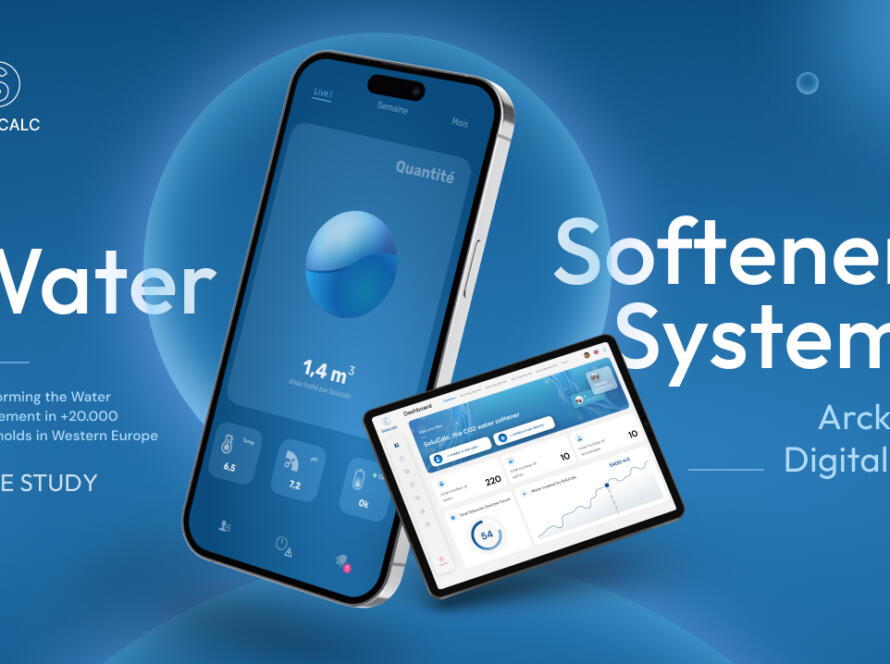Last Update: 01.07.2024
In today’s fast-paced digital landscape, the value of digital products hinges not just on their functionality but on the user experience (UX) they offer. This aspect has become a critical determinant in the valuation of digital products, influencing both market perception and investor confidence. As businesses strive to differentiate themselves, understanding the nuances of UX and its impact on valuation is essential for entrepreneurs, investors, and business leaders alike.
At Arckipel, we have consistently observed that many of our clients tend to underestimate the significance of UX in their digital products. This oversight can lead to missed opportunities and diminished product value. We are launching our series, “Top Drivers of Digital Product Value,” where we will delve into the different aspects, making up the value of a digital product today. This first article sheds light on how an enhanced user experience serves as the cornerstone for significantly increasing the value of digital products.
The Imperative of User Experience in Digital Products
User experience encompasses every interaction a user has with a digital product, from the initial interface to ongoing support. A well-designed UX can significantly enhance customer satisfaction, increase user engagement, and foster loyalty—all of which are crucial for driving value.
Strategic Importance of UX in Valuation
The value of digital products is heavily influenced by the user experience (UX) they offer. A strong UX can elevate a product’s market perception and investor confidence. This section explores the strategic importance of UX in valuation, focusing on intuitive design, personalization, user engagement, and building long-term value through retention and customer loyalty.
What is an Intuitive Design?
An intuitive design is one that is easy for users to understand and navigate without requiring extensive instructions. It aligns with users’ natural behaviors and expectations, making interactions seamless and straightforward. Key characteristics of intuitive design include:
- Consistency: Elements are consistent throughout the product, so users can predict how different parts of the product will function.
- Feedback: Users receive immediate feedback on their actions, helping them understand the consequences and guiding them towards desired outcomes.
- Simplicity: The design eliminates unnecessary complexity, focusing on essential functions and features.
Apple’s iOS exemplifies intuitive design. Its interface is clean, consistent, and provides immediate feedback, making it accessible even to new users. This ease of use significantly enhances user satisfaction and contributes to Apple’s high market value.
How Does Intuitive Design Increase Interaction?
Intuitive design increases user interaction by making digital products more accessible and enjoyable to use. When users can navigate a product effortlessly, they are more likely to engage with its features and spend more time using it. This increased interaction can lead to higher user satisfaction and loyalty.
For instance, Apple’s iOS is designed to be user-friendly, which has helped maintain a high customer retention rate. Users are more likely to explore and utilize the features of an intuitively designed product, leading to increased engagement and a higher perceived value. Research indicates that 70% of customers abandon products with poor usability, underscoring the importance of intuitive design.
At Arckipel, we implemented these principles in our overhaul of the SiBa App. By focusing on modern UX/UI design principels, we transformed DsiN’s outdated mobile app into a user-friendly, visually appealing, and highly functional tool. This redesign not only aligned with the brand’s new aesthetics but also significantly enhanced user interaction and satisfaction.
To learn more about our approach and the impact of these changes, read our detailed case study on the SiBa App revitalization here.

Personalization: Cornerstone of Increased Interaction
Personalization tailors the user experience to individual preferences and behaviors, making interactions more relevant and engaging. By analyzing user data, digital products can offer personalized recommendations, content, and features that resonate with users on a personal level.
Personalization tailors the user experience to individual preferences and behaviors, making interactions more relevant and engaging. By analyzing user data, digital products can offer personalized recommendations, content, and features that resonate with users on a personal level.
Amazon’s recommendation engine is a prime example. By leveraging algorithms that analyze browsing and purchase habits, Amazon suggests products that align with individual preferences. This personalized approach significantly enhances user engagement and retention. According to studies, Amazon’s personalized recommendations account for up to 35% of its total sales. The seamless integration of personalization into the shopping experience has led to higher user satisfaction and increased market value.
Personalized experiences lead to higher user satisfaction and can significantly boost a product’s market value. According to McKinsey, personalization can deliver five to eight times the ROI on marketing spend and lift sales by 10% or more. Amazon’s success with personalization underscores the power of this strategy in driving user engagement and enhancing product value.
User Engagement: A Critical Factor to Increase Valuation
User engagement is essential for increasing the valuation of digital products. Engaged users are more likely to become loyal customers, advocate for the product, and contribute to its sustained success.
How to Use UX to Build Long-Term Valuation Through Retention and Customer Loyalty
Building long-term value through retention and customer loyalty involves several key strategies:
- Consistent Performance: Reliability and speed are crucial. Users must trust that the product will perform consistently well. Amazon’s efficient service and user-friendly interface have cemented its market leadership and contributed to its high valuation. Research shows that 73% of users will abandon a product if it is unreliable.
- Robust Customer Support: Providing excellent customer support enhances user trust and retention. Zendesk’s focus on superior customer support has positioned it as a leading customer service software provider, demonstrating how robust support can drive long-term user loyalty.
- Gamification: Incorporating game-like elements can make the user journey more engaging. Duolingo’s use of gamification enhances learning and keeps users motivated, contributing to its attractiveness to users and investors alike. Studies indicate that gamification can increase user engagement by up to 50%.
- Holistic User Journey: Consider the entire user journey, from onboarding to long-term use. Ensuring a seamless and satisfying experience at every touchpoint can foster long-term loyalty. Tailoring onboarding experiences, providing continuous value, and regularly updating the product based on user feedback are critical steps.
Case Studies Highlighting UX-Driven Valuation
-
Airbnb: Revolutionizing Travel Through UX
- User-Centric Design: Airbnb’s platform is designed to make booking and hosting effortless, which has been key to its rapid growth and high valuation.
- Community Building: Features that foster a sense of community, such as reviews and personalized recommendations, have enhanced user trust and engagement.
-
Spotify: Leading the Music Streaming Market
- Personalized Experience: Spotify’s use of algorithms to create personalized playlists keeps users engaged and loyal, significantly contributing to its market valuation.
- User-Friendly Interface: Its intuitive interface makes it easy for users to discover and enjoy music, enhancing satisfaction and retention.
-
Tesla: Merging UX with Technological Innovation
- Innovative Interface: Tesla’s in-car interface is designed to be user-friendly and futuristic, setting it apart in the automotive industry.
- Customer Experience: From online car purchasing to over-the-air updates, Tesla prioritizes user experience, driving its premium valuation.
Example of UX Driving Competitive Success: Slack vs. HipChat
A common question in the tech industry is why so many software tools that perform similar functions receive significant funding. The answer lies in the importance of user experience (UX) design. Investors in the US, in particular, recognize that superior UX design can dramatically increase a company’s valuation. This is evident in the competition between Slack and HipChat in the niche market of team communication tools.
In the early days, HipChat was a prominent player with a solid user base, offering straightforward messaging capabilities aimed at improving team collaboration. It provided essential features such as group chat, direct messaging, and integrations with other tools, making it a comprehensive solution for businesses.
However, when Slack entered the market, it prioritized user experience to an unprecedented degree. Slack’s emphasis on an intuitive, visually appealing interface that was easy to navigate quickly set it apart. This focus on UX allowed Slack to outgrow and eventually overshadow HipChat. Here’s how Slack’s superior UX design drove its competitive success:
HipChat: The Initial Player
- Initial Success: HipChat, launched in 2010, quickly became popular for its straightforward messaging capabilities aimed at improving team collaboration.
- Features: It offered group chat, direct messaging, and integrations with other tools, making it a comprehensive solution for businesses.
Slack: The UX-Driven Competitor
- Enhanced UX Design: When Slack launched in 2013, it prioritized an intuitive, visually appealing interface that was easy to navigate. Its playful design elements, like emoji reactions and custom themes, made the platform more engaging.
- Seamless Integrations: Slack excelled in integrating with a wide array of third-party applications, allowing users to customize their workflows seamlessly. This integration capability was more user-friendly and robust compared to HipChat.
- Onboarding and Support: Slack’s onboarding process was smoother, with helpful guides and an intuitive setup that allowed teams to get started quickly. Additionally, Slack’s customer support was highly responsive and accessible.
- Community and Feedback: Slack actively engaged with its user community, frequently updating the platform based on user feedback. This responsiveness helped to continuously improve the user experience and keep users satisfied.
Outcome: Slack’s superior UX resulted in rapid user adoption and high user satisfaction, which drove its valuation upwards. By 2017, Slack had raised over $540 million and was valued at $5.1 billion, while HipChat struggled to keep up and was eventually acquired by Slack’s parent company, Atlassian, and discontinued in 2018. This example highlights how a focus on UX can enable a company to outpace established competitors and achieve higher market valuation.
Investors recognize that companies with better UX design are more likely to succeed in the market, attract and retain users, and generate higher returns on investment. This awareness drives significant funding into companies that prioritize UX, as a well-designed user experience can be a key differentiator in a crowded market. By understanding and leveraging the strategic importance of UX, companies can enhance their competitive edge and valuation.
Strategies for Enhancing UX and Increasing Valuation
-
User Research and Feedback:
- Conducting thorough user research to understand needs and pain points ensures the product meets user expectations.
- Regularly soliciting and incorporating user feedback helps maintain relevance and satisfaction.
-
Continuous Improvement:
- Iteratively enhancing the product based on user feedback and technological advancements keeps the product competitive.
- Focusing on both aesthetic and functional improvements ensures a balanced user experience.
-
Holistic Approach:
- Considering the entire user journey—from onboarding to long-term use—ensures a comprehensive and satisfying experience.
- Integrating features that add value to users’ lives, such as personalization and convenience, can differentiate the product in the market.
-
Investing in Design and Development:
- Allocating resources to UX design and development demonstrates a commitment to quality, attracting users and investors.
- Training teams in UX best practices ensures the product consistently meets high standards.
Conclusion
Valuation through enhanced user experience is not just about creating a product that works; it’s about creating a product that resonates with users on multiple levels. By prioritizing UX, companies can build products that not only attract and retain users but also command higher valuations in the market. This strategic focus on UX is crucial for long-term success and sustainability in the competitive digital landscape.
At Arckipel, we specialize in guiding businesses through the complexities of digital transformation, ensuring that their products deliver exceptional user experiences that drive value and growth. Stay tuned for the next episode in our series, where we delve deeper into the role of scalability in digital product valuation.
Want to read the rest of this series to learn how to create a valuable digital product?
Engage with us in the comments section and follow our blog for more insights on digital product valuation.




